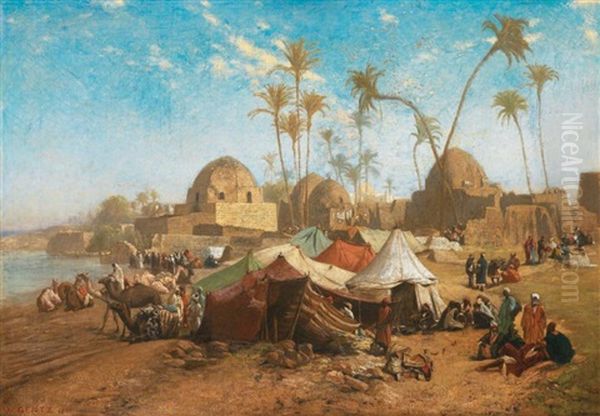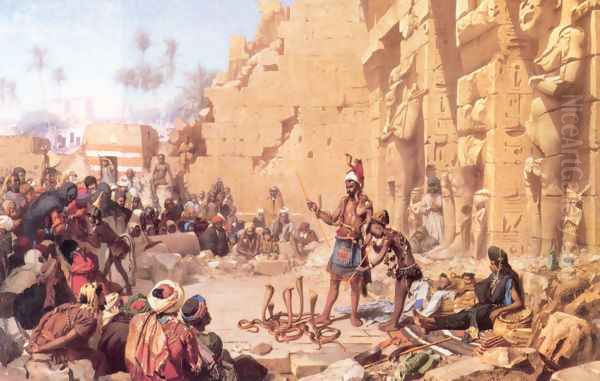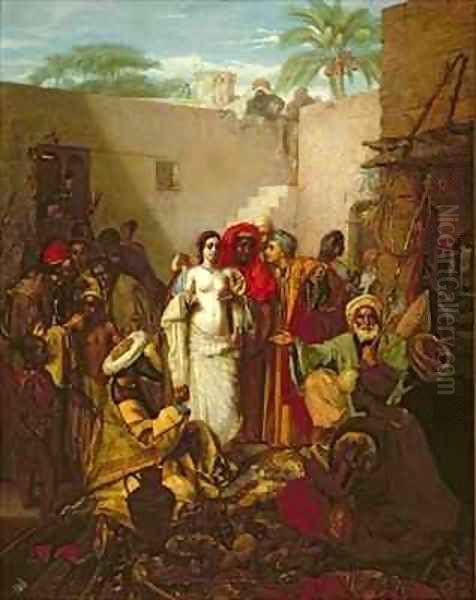Wilhelm Karl Gentz stands as a significant, if sometimes underappreciated, figure in the landscape of 19th-century European art. A prominent German painter, he dedicated much of his prolific career to the depiction of the "Orient"—a term then encompassing North Africa, the Middle East, and Ottoman territories. His work, characterized by meticulous detail, vibrant color, and a keen observational eye, offers a fascinating window into both the lands he depicted and the European perceptions of them during a period of intense colonial expansion and burgeoning global travel. Born in an era of artistic transition, Gentz navigated the currents of Realism and Romanticism, ultimately forging a distinctive style that set him apart from many of his contemporaries.
Early Life and Artistic Formation
Wilhelm Karl Gentz was born on December 9, 1822, in Neu-Ruppin, a town in the Margraviate of Brandenburg, Prussia (now Germany). His father was a Prussian civil servant, and his mother hailed from a French Huguenot family that had settled in Berlin, bringing a certain cosmopolitan influence to his upbringing. This background likely instilled in him a sense of discipline and an openness to diverse cultures from an early age. His initial artistic inclinations led him to Berlin, where he commenced his formal studies at the prestigious Royal Prussian Academy of Arts (Königlich Preußische Akademie der Künste). The Berlin Academy, at that time, was a bastion of academic tradition, emphasizing rigorous training in drawing and classical principles, a foundation that would serve Gentz well throughout his career.
Seeking to broaden his artistic horizons, Gentz later moved to Antwerp, Belgium, to study at the Royal Academy of Fine Arts. Antwerp, with its rich artistic heritage, particularly from the Flemish Baroque period exemplified by masters like Peter Paul Rubens and Anthony van Dyck, offered a different pedagogical environment. Here, he would have been exposed to a tradition that prized rich color, dynamic compositions, and a robust engagement with worldly subjects. This experience undoubtedly contributed to his later mastery of color and his ability to animate complex scenes.

His educational journey did not end there. Paris, the undisputed art capital of 19th-century Europe, beckoned. Gentz continued his studies in the French metropolis, a melting pot of artistic innovation and debate. Crucially, he entered the ateliers of renowned painters. Among his teachers was Charles Gleyre, a Swiss artist who ran a highly influential independent studio. Gleyre, himself a traveler to the Eastern Mediterranean in his youth, was known for his academic precision but also for encouraging his students' individual talents. His studio was a training ground for an astonishing array of future luminaries, including Claude Monet, Pierre-Auguste Renoir, Alfred Sisley, and James Abbott McNeill Whistler, though Gentz's path would diverge significantly from these Impressionists. Gentz also reportedly studied with Jean-Baptiste-Camille Corot, a pivotal figure in French landscape painting, whose emphasis on capturing light and atmosphere, particularly in his en plein air sketches, may have influenced Gentz's approach to rendering the unique light of the Orient.
The Allure of the Orient: Travels and Inspirations
The mid-19th century witnessed a surge in European fascination with the East, fueled by colonial ambitions, archaeological discoveries, improved travel, and romantic literature. For artists, the "Orient" offered a vibrant palette, exotic subjects, and a perceived escape from the perceived staidness of European society. Wilhelm Gentz was profoundly drawn to these distant lands, and his career became inextricably linked with his extensive travels. Unlike some "armchair Orientalists" who relied on second-hand accounts or studio props, Gentz was an intrepid traveler, undertaking numerous journeys that provided him with authentic, first-hand material for his paintings.
His travels took him across a vast swathe of the Mediterranean and Middle Eastern world. He journeyed to Spain, where the Moorish heritage, particularly in Andalusia, provided a tantalizing glimpse of Islamic art and architecture on European soil. Morocco, with its vibrant souks, distinct cultural traditions, and dramatic landscapes, became another key destination. However, it was perhaps Egypt that captivated him most profoundly. He sailed the Nile, sketched ancient temples, and observed the daily life of its people, from bustling Cairo to the quieter villages of Upper Egypt and Nubia.
Gentz's explorations also extended to Palestine, a land of immense religious and historical significance for Europeans. He visited Jerusalem and other biblical sites, experiences that would later translate into some of his most ambitious historical compositions. Further east, his travels encompassed Armenia, parts of Asia Minor (modern-day Turkey), and even Persia (modern-day Iran). These journeys were not mere tourist excursions; they were intensive periods of sketching, observation, and cultural immersion. He meticulously documented architectural details, local costumes, social customs, and the unique qualities of light and atmosphere in each region. This dedication to ethnographic accuracy, combined with his artistic skill, lent a powerful sense of authenticity to his work. He was particularly fascinated by what he perceived as the "golden age" of Arab architecture, and this passion is evident in the detailed rendering of buildings in many of his paintings.
Artistic Style, Themes, and Notable Works

Wilhelm Gentz's artistic style can be broadly categorized as Orientalist Realism. While the subject matter was often exotic and imbued with a certain romantic allure inherent in the Orientalist genre, his approach to rendering these scenes was grounded in careful observation and a commitment to verisimilitude. His North German upbringing and Berlin training likely contributed to a certain rigor and precision in his work, which contrasted with the more overtly flamboyant or theatrical tendencies of some French Orientalists like Eugène Delacroix or Jean-Léon Gérôme, though Gérôme himself was also known for his meticulous detail.
Color was a hallmark of Gentz's art. He possessed a remarkable ability to capture the intense light and rich hues of the Eastern Mediterranean, from the dazzling sunlight on desert sands to the cool shadows within ancient souks. His palette was vibrant yet controlled, avoiding garishness and instead achieving a harmonious balance that conveyed both the brilliance and the subtlety of the scenes he depicted. Critics of his time often lauded him as one ofthe finest colorists of the Berlin school.
His thematic concerns were diverse, encompassing landscapes, genre scenes, architectural studies, and historical narratives. He painted bustling marketplaces, quiet moments of prayer, lively gatherings of storytellers, caravans traversing the desert, and portraits of local figures. These genre scenes are particularly valuable for their depiction of everyday life, offering glimpses into social customs, attire, and activities.
Among his most celebrated works is the monumental painting, The Entry of Crown Prince Frederick William of Prussia into Jerusalem in 1869. This large-scale composition, now housed in the Alte Nationalgalerie in Berlin, depicts a significant historical event with a wealth of detail and a grand sense of occasion. It showcases Gentz's ability to handle complex multi-figure compositions, his skill in rendering architectural settings, and his mastery of color and light. The painting captures the pomp and circumstance of the event while also providing a vivid portrayal of the diverse crowd gathered to witness it.
Another iconic work is Prayer in the Desert. This painting, existing in several versions, captures a caravan of Bedouins halting their journey for prayer as the sun sets over the vast expanse of the desert. The scene is imbued with a sense of solemnity and spiritual devotion, set against a backdrop of breathtaking natural beauty. The warm glow of the setting sun, the elongated shadows, and the reverent postures of the figures create a powerful and evocative image. It reflects a common Orientalist theme, but Gentz handles it with a sensitivity that avoids overt exoticism.

Other significant paintings include Arab Story-Tellers at Cairo, which vividly portrays a captivated audience listening to a narrator in a traditional coffeehouse setting, highlighting the importance of oral tradition in the culture. The Snake Charmer, often set against the backdrop of ancient Egyptian ruins like Medinet Habu, is another recurring theme in Orientalist art, and Gentz’s versions are noted for their ethnographic detail and atmospheric rendering. He also painted scenes like Evening on the Nile, capturing the serene beauty of the river at dusk, and Campement auprès des Mausolées (Encampment near the Mausoleums, 1863), showcasing his skill in depicting nomadic life.
Gentz in the Context of 19th-Century Orientalism
The 19th century was the golden age of Orientalist painting, and Wilhelm Gentz was a key German contributor to this widespread European artistic phenomenon. While French artists like Eugène Delacroix, with his dramatic and romantic visions of North Africa (e.g., Women of Algiers in their Apartment), and Jean-Léon Gérôme, with his highly polished and often sensual depictions (e.g., The Snake Charmer, The Slave Market), often dominate discussions of Orientalism, artists from other nations also made significant contributions.
In Britain, painters like David Roberts, known for his meticulous topographical views of Egypt and the Holy Land, and John Frederick Lewis, who lived in Cairo for a decade and produced incredibly detailed genre scenes, were highly influential. Edward Lear, famed for his nonsense verse, was also a gifted topographical painter who traveled extensively in the East.
Germany, too, had its share of Orientalist painters, though perhaps they did not achieve the same level of international fame as their French or British counterparts. Artists like Adolf Schreyer, a contemporary of Gentz, was known for his dramatic depictions of Arab horsemen and scenes from Wallachia and Algeria. Gustav Bauernfeind, slightly younger than Gentz, became one of the most commercially successful German Orientalists, renowned for his incredibly detailed and luminous cityscapes of Jerusalem, Damascus, and Jaffa. Earlier figures like Johann Martin von Rohden, though primarily associated with Italianate landscapes, also touched upon Eastern themes, reflecting a broader German Romantic interest in distant lands.
Gentz's work stands out within this context for its particular blend of German thoroughness and a genuine, observational approach. While all Orientalist art is, to some extent, a product of the European colonial gaze and can be subject to critiques regarding its representation of Eastern cultures, Gentz's paintings often convey a sense of respect and a desire for authentic portrayal. His style was described by some as "thorough realism," infused with a "North German rigor" and even a touch of "Berlin humor," setting him apart from the more overtly romantic or sensationalist approaches of some of his French contemporaries. He was considered one of the leading figures of the Berlin school of painting in his specialty.
The competitive landscape of Orientalist art was fierce. French painters, benefiting from France's colonial presence in North Africa and the strong institutional support for the arts in Paris, often set the standard. Gentz and other German Orientalists were, in a sense, competing in this international arena, and while their work was highly regarded in Germany, it sometimes received less attention than that of their French peers on the broader European stage. Nevertheless, Gentz's dedication to his subject matter and the quality of his output secured him a lasting reputation.
Private Life, Social Activities, and Legacy
Details about Wilhelm Gentz's private life are not as extensively documented as his artistic career, but certain aspects are known. He was deeply committed to his art, and his life revolved around his travels, his studio work, and his engagement with the art world. His journeys were not just for sketching; he also collected artifacts and objects from the East, which he brought back to Berlin. These items likely served as studio props and furthered his understanding of the material culture of the regions he depicted.
Gentz was an active participant in the cultural life of Berlin. He exhibited his works regularly, contributing to the growing public interest in Oriental themes. Through his paintings, exhibitions, and possibly through published accounts or lectures (though specific records of these are scarce), he helped to shape German perceptions of the Middle East. His efforts to share his experiences and the art he encountered or was inspired by played a role in the broader cultural exchange, however filtered through a European lens, between Germany and the Eastern Mediterranean.
His family home in Neu-Ruppin, which likely housed many of his sketches, studies, and perhaps some finished works, tragically fell victim to the ravages of World War II. The destruction of the house meant the loss of a significant portion of his personal archive and potentially some artworks. Despite these losses, a number of his paintings survived and are now held in public and private collections, with the Neuruppin Museum holding a notable collection, ensuring his work remains accessible. The Alte Nationalgalerie in Berlin, as mentioned, holds his magnum opus, The Entry of Crown Prince Frederick William into Jerusalem. His works also appear in other museum collections and occasionally surface at auctions, such as at the Dorotheum in Vienna.
Wilhelm Karl Gentz passed away on August 23, 1890, in Berlin. He left behind a substantial body of work that continues to be valued for its artistic merit and its historical insights. His paintings offer a German perspective on the Orientalist phenomenon, characterized by a meticulous realism, a brilliant use of color, and a deep engagement with the cultures he portrayed. While the broader field of Orientalist art has undergone critical re-evaluation in recent decades, with scholars examining its colonial underpinnings and its role in constructing Western stereotypes of the East, Gentz's work remains an important part of this complex artistic and cultural history. His dedication to first-hand observation and his evident respect for many aspects of the cultures he encountered distinguish his contributions. He remains a testament to the power of art to bridge worlds, even as it reflects the perspectives and preoccupations of its own time. His legacy is that of a skilled and dedicated artist who brought the landscapes, light, and life of the "Orient" to vivid realization for his European audience.